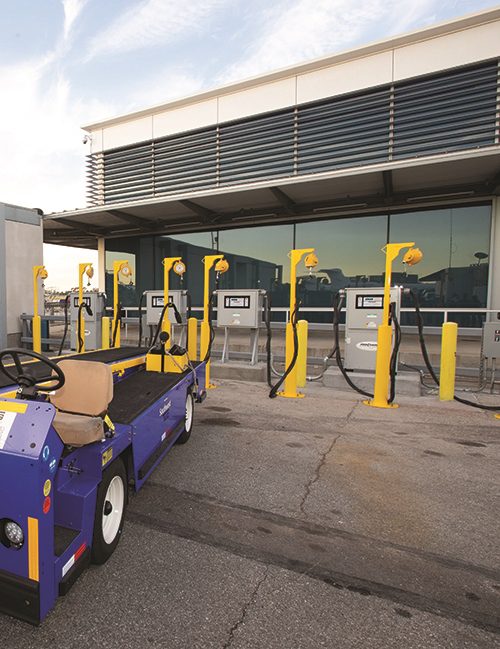Every new airport executive wants to hit the ground running and complete projects that are electrifying. In her first year as director of Long Beach Airport (LGB), Cynthia Guidry pulled it off—literally. When Guidry arrived at the Southern California airport, LGB had already approved a project to install 15 electric chargers for airline ground support equipment. In fact, the project was just going out to bid when she assumed the helm last July.
Every new airport executive wants to hit the ground running and complete projects that are electrifying. In her first year as director of Long Beach Airport (LGB), Cynthia Guidry pulled it off—literally.
 When Guidry arrived at the Southern California airport, LGB had already approved a project to install 15 electric chargers for airline ground support equipment. In fact, the project was just going out to bid when she assumed the helm last July. Completing the $1.4 million construction project while serving passengers and avoiding operational disruptions was like baptism by fire.
When Guidry arrived at the Southern California airport, LGB had already approved a project to install 15 electric chargers for airline ground support equipment. In fact, the project was just going out to bid when she assumed the helm last July. Completing the $1.4 million construction project while serving passengers and avoiding operational disruptions was like baptism by fire.
But she pulled it off early this year, and now all 11 of LGB’s commercial gates are fully electrified. As a result, the airport is on track to decrease harmful nitrogen oxide emissions by nearly 2,000 pounds per year by 2023. Southern California is especially attuned to reducing nitrogen oxide emissions, due to their link with air pollution.
|
facts&figures Project: Gate Electrification Location: Long Beach (CA) Airport Scope: 15 new electric chargers for ground support equipment to cover all 11 commercial gates Cost: $1.4 million Funding: Airport revenue (pending expected approval of VALE grant, passenger facility charges will be used) Designer: HNTB Contractor: Royal Electric Charging Stations: PosiCharge Samples of Electric Equipment: Ground power units from ITW GSE; preconditioned air units from TLD; belt loaders from TUG Technologies; Lektro pushback/tow vehicles from JBT Airline Participation: American, Delta, Hawaiian, JetBlue & Southwest agreed to convert their ground support equipment to electric Notable Progress: Southwest has converted more than 80% of its ground support equipment at LGB; JetBlue’s fleet at the airport is more than 55% electric Expected Impact: Reducing nitrogen oxide emissions by nearly 2,000 pounds/year by 2023 |
Personnel from LGB’s Engineering Department note that the new PosiCharge units provide numerous operational benefits. In addition to being faster and more efficient than previous chargers, they recognize each specific battery type and charge accordingly to prolong the life of individual batteries. The new equipment also includes a feature that sends email alerts and notifications about the health of the chargers and fleet equipment, usage data, etc. A cable management system helps prevent vehicles from rolling over and damaging cables.
Guidry is quick to credit the airport’s staff and airlines for their roles in the project. “It took the carriers as well as our team to make this program successful,” she says. “Our airline partners were a vital part of the entire project. Communication was essential. We talked with the carriers early in the planning stages and throughout, and they were always supportive in wanting to do it.”
Guidry left her position as deputy executive director at Los Angeles International Airport, where she had worked for 18 years, to accept the top spot at LGB.
Going All In
The electrification project was paid for with airport revenue, but LGB applied for an FAA Voluntary Airport Low Emissions (VALE) grant to help defray most of the cost and also allow the airport to use passenger facility charges.
The project stemmed from a need that arose more than two years ago to upgrade the airport’s charging stations. However, instead of replacing the existing five units, LGB invested in 15 new charging stations—with the express support of its carriers (American Airlines, Delta Air Lines, Hawaiian Airlines, JetBlue Airways and Southwest Airlines). As a block, the carriers agreed to invest in electric ground support equipment, which aligned with their respective corporate goals.
“If an airport is willing to provide the infrastructure, and they approach us with an opportunity to lower emissions through conversion to electric ground support equipment, we are typically willing to do it depending on our need to refresh the fleet and the regulatory environment,” says Adam Walters, environmental manager of Southwest’s Environmental Services Team. “We want to take advantage of those opportunities because we recognize the long-term savings involved with electrification.”
 Walters reports that Southwest has electrified about 27% of its eligible ground support equipment nationwide, but its fleet at LGB is more than 80% electric (among the highest in the country for the airline).
Walters reports that Southwest has electrified about 27% of its eligible ground support equipment nationwide, but its fleet at LGB is more than 80% electric (among the highest in the country for the airline).
As part of its effort to electrify at LGB, Southwest purchased six electric baggage tugs that had been taken out of use at nearby John Wayne Airport (SNA) in Orange County. Airline personnel managed to nab the equipment just before it went to auction.
The airline has also purchased a number of new units in the last few years: three electric ground power units from ITW GSE, two electric preconditioned air units from TLD and six electric belt loaders from TUG Technologies. The modern diesel pushback tugs it uses at LGB will eventually be converted to electric, and the electric baggage tugs from SNA will be replaced with new units.

Early Commitment
“When we started serving Long Beach in 2016, we committed to electrify as much as possible,” explains Larry Pitts, Southwest’s station operations manager at LGB. Pitts welcomed the airport’s subsequent charging station project because airlines had to compete for overnight charging time when there were only five stations available. It would have been impractical for Southwest to add more electric ground support equipment if extra chargers were not installed, he explains.
 According to Pitts, LGB not only met Southwest’s need for more charging stations, it also bent over backward to accommodate the airline’s operational needs during the associated construction. “When they install these things, they have to bring in cranes and there is a lot of coordination and communication,” he remarks. “I was very impressed with how they worked to make it as seamless as possible.”
According to Pitts, LGB not only met Southwest’s need for more charging stations, it also bent over backward to accommodate the airline’s operational needs during the associated construction. “When they install these things, they have to bring in cranes and there is a lot of coordination and communication,” he remarks. “I was very impressed with how they worked to make it as seamless as possible.”
Naturally, airlines eliminate fuel costs when they electrify ground support equipment. But many expect to save even more money on vehicle maintenance. “There are no leaky engines, no disposal of waste when changing fluids and parts,” explains Walters. “It’s definitely more than just saving on fuel.”
A Preference For Electric
The move to electric vehicles is also popular with ground crews. An internal survey at JetBlue found that more than 90% of employees prefer electric ground support equipment to vehicles powered by fossil fuels. “They’re quiet, clean and reliable,” says Sara Bogdan, manager of sustainability and environmental social governance for the airline.

David Farias, general manager of system ground services for JetBlue, notes that the airline converted several diesel engine units to electric even before the airport initiated its charging station project. Now, the majority of its belt loaders and baggage tugs at LGB are electric. In 2016 and 2017, JetBlue purchased two electric pushbacks, and added more electric units later in 2017. Currently, about 55% of its ground support equipment at LGB is electric.
 Bogdan reports that JetBlue is on pace to beat its goal of converting 40% of its nationwide ground support fleet to electric by 2025 and 50% by 2030. When deciding where to invest in electric vehicles, JetBlue considers the size and age of existing fleets, as well as which airports have the interest, ability and funding to partner on conversion projects. As Bogdan sees it, the move to electric ground support equipment is a “slam dunk” from a community and business perspective.
Bogdan reports that JetBlue is on pace to beat its goal of converting 40% of its nationwide ground support fleet to electric by 2025 and 50% by 2030. When deciding where to invest in electric vehicles, JetBlue considers the size and age of existing fleets, as well as which airports have the interest, ability and funding to partner on conversion projects. As Bogdan sees it, the move to electric ground support equipment is a “slam dunk” from a community and business perspective.
But commercial airlines aren’t the only tenants making the switch. JBT reports that it has supplied six Lektro vehicles to various general aviation businesses at LGB. Operators use the all-electric, towbarless units to push aircraft back from gates and tow them about the tarmac.

Wait, There’s More
New charging stations and electric ground support equipment are important components of LGB’s larger effort to reduce emissions from non-aircraft mobile sources. It is one of five commercial airports in the South Coast Air Basin that recently finalized a collaborative agreement with the South Coast Air Quality Management District. In addition to greening ground support equipment, the group’s Air Quality Improvement Plan sets voluntary targets for renewable energy, sustainable design, clean construction practices and clean fleet goals for airport-owned vehicles.
“This is just part of the many things we want to do,” Guidry says of the recent charging stations project.
Construction of a new ticketing area,the next phase of terminal improvements, is expected to earn LEED Silver certification. The airport also is installing solar panels on a parking garage and adding more electric charging stations for customers’ vehicles.



